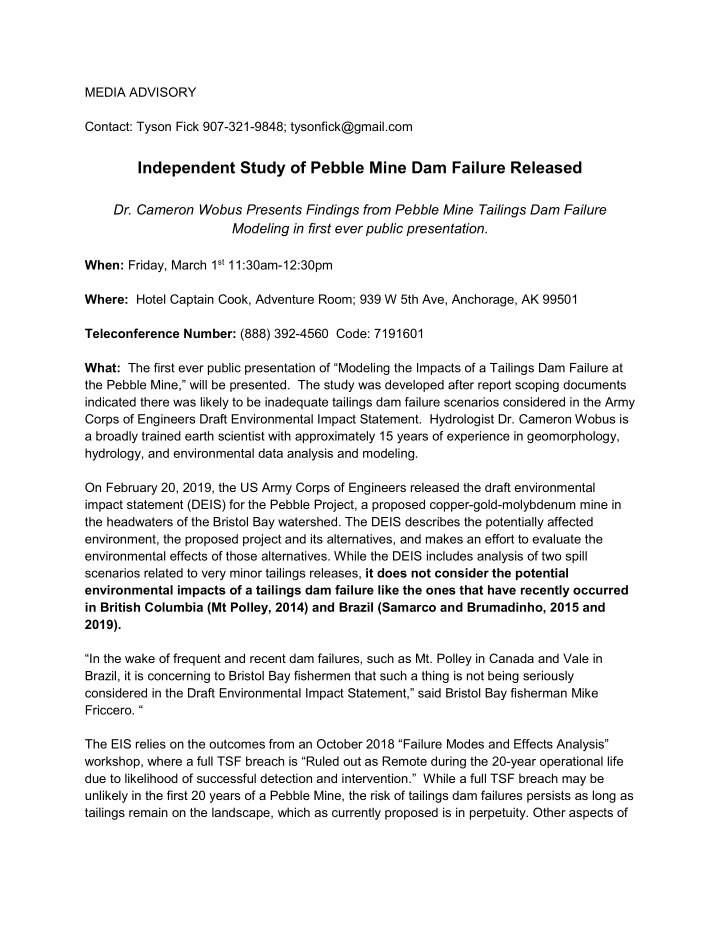



MEDIA ADVISORY Contact: Tyson Fick 907-321-9848; tysonfick@gmail.com Independent Study of Pebble Mine Dam Failure Released Dr. Cameron Wobus Presents Findings from Pebble Mine Tailings Dam Failure Modeling in first ever public presentation. When: Friday, March 1 st 11:30am-12:30pm Where: Hotel Captain Cook, Adventure Room; 939 W 5th Ave, Anchorage, AK 99501 Teleconference Number: (888) 392-4560 Code: 7191601 What: The first ever public presentation of “Modeling the Impacts of a Tailings Dam Failure at the Pebble Mine,” will be presented. The study was developed after report scoping documents indicated there was likely to be inadequate tailings dam failure scenarios considered in the Army Corps of Engineers Draft Environmental Impact Statement. Hydrologist Dr. Cameron Wobus is a broadly trained earth scientist with approximately 15 years of experience in geomorphology, hydrology, and environmental data analysis and modeling. On February 20, 2019, the US Army Corps of Engineers released the draft environmental impact statement (DEIS) for the Pebble Project, a proposed copper-gold-molybdenum mine in the headwaters of the Bristol Bay watershed. The DEIS describes the potentially affected environment, the proposed project and its alternatives, and makes an effort to evaluate the environmental effects of those alternatives. While the DEIS includes analysis of two spill scenarios related to very minor tailings releases, it does not consider the potential environmental impacts of a tailings dam failure like the ones that have recently occurred in British Columbia (Mt Polley, 2014) and Brazil (Samarco and Brumadinho, 2015 and 2019). “In the wake of frequent and recent dam failures, such as Mt. Polley in Canada and Vale in Brazil, it is concerning to Bristol Bay fishermen that such a thing is not being seriously considered in the Draft Environmental Impact Statement,” said Bristol Bay fisherman Mike Friccero. “ The EIS relies on the outcomes from an October 2018 “Failure Modes and Effects Analysis” workshop, where a full TSF breach is “Ruled out as Remote during the 20-year operational life due to likelihood of successful detection and intervention.” While a full TSF breach may be unlikely in the first 20 years of a Pebble Mine, the risk of tailings dam failures persists as long as tailings remain on the landscape, which as currently proposed is in perpetuity. Other aspects of
the proposed tailings facility at Pebble suggest that such a failure is not “Remote”, and warrants further consideration: ● The bulk tailings facility is an order of magnitude larger (i.e.,10 times larger) than the facilities that failed at Mt. Polley and Samarco; ● The dam that must hold these tailings back, in perpetuity, uses a design that USACE itself notes is not as stable as other designs, particularly in seismically active areas; ● The more than 1.3 meters of annual precipitation that falls at the site suggests that the tailings are very likely to remain wet and unstable long after mine operations cease. ● There are very real risks of seismicity at the site that could destabilize the facility and cause a breach. Furthermore, Pebble Limited Partnership has hired Knight Piesold – the same engineering company who designed the failed Mt. Polley tailings facility – to design the tailings dam using a nearly identical design to the one that failed there. “The fact that fishermen had to fund this scientific analysis in order to get an accurate look at Pebble’s proposed environmental impacts is outrageous and puts the burden on fishermen and Alaskans. That’s not how our federal permitting system should work. This is just one of the areas we view as woefully inadequate. They should go back to the drawing board,” Mr. Friccero said. Dam failure scenario digital model of showing sediment flowing well beyond the modeling area.
About Dr. Cameron Wobus Dr. Wobus is a Senior Scientist at Lynker Technologies, where he specializes in climate change impacts, mitigation, and adaptation, particularly for the water sector. In 2015 Dr. Wobus led a team of scientists in the development an integrated hydrologic model of the upper Nushagak and Kvichak watersheds in the Bristol Bay region to better understand the potential impacts of the proposed Pebble Mine.
Recommend
More recommend